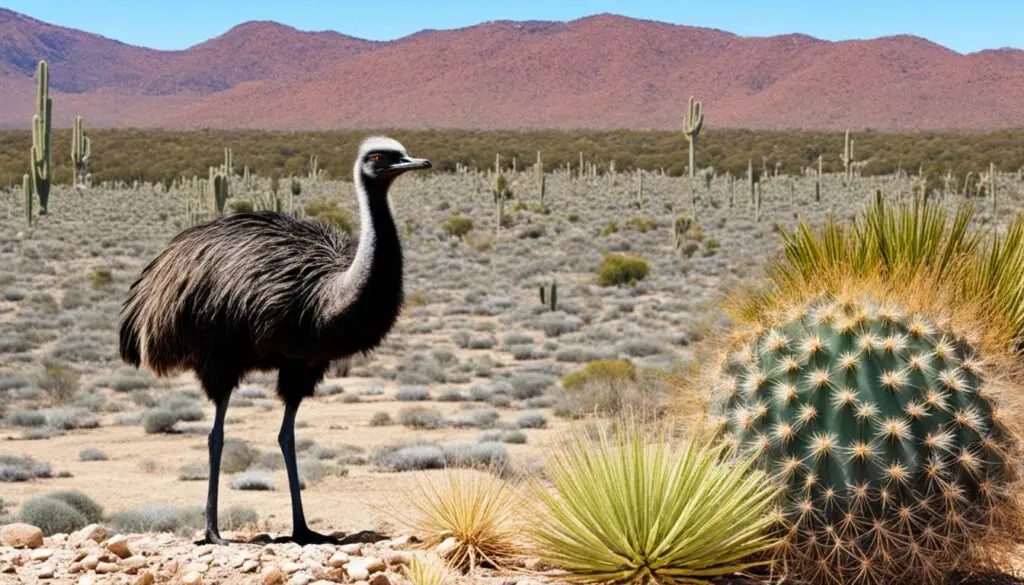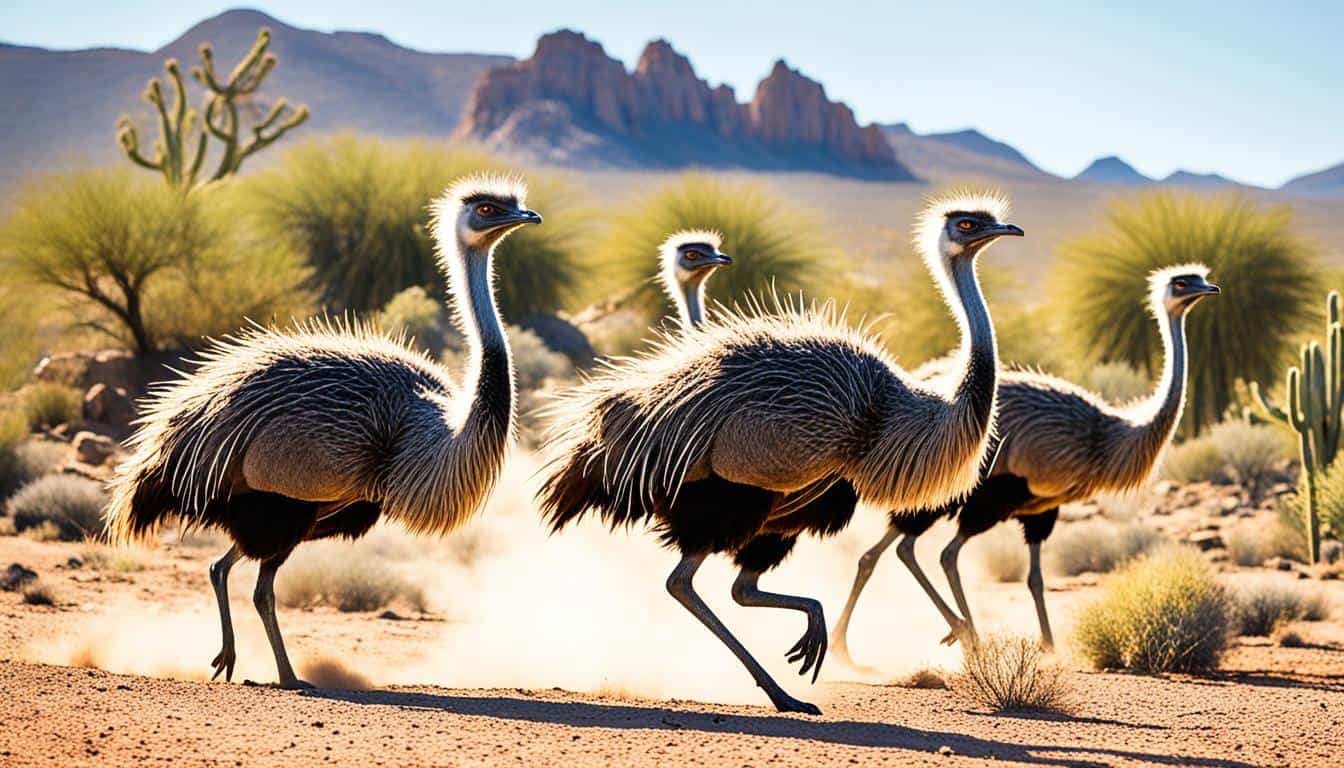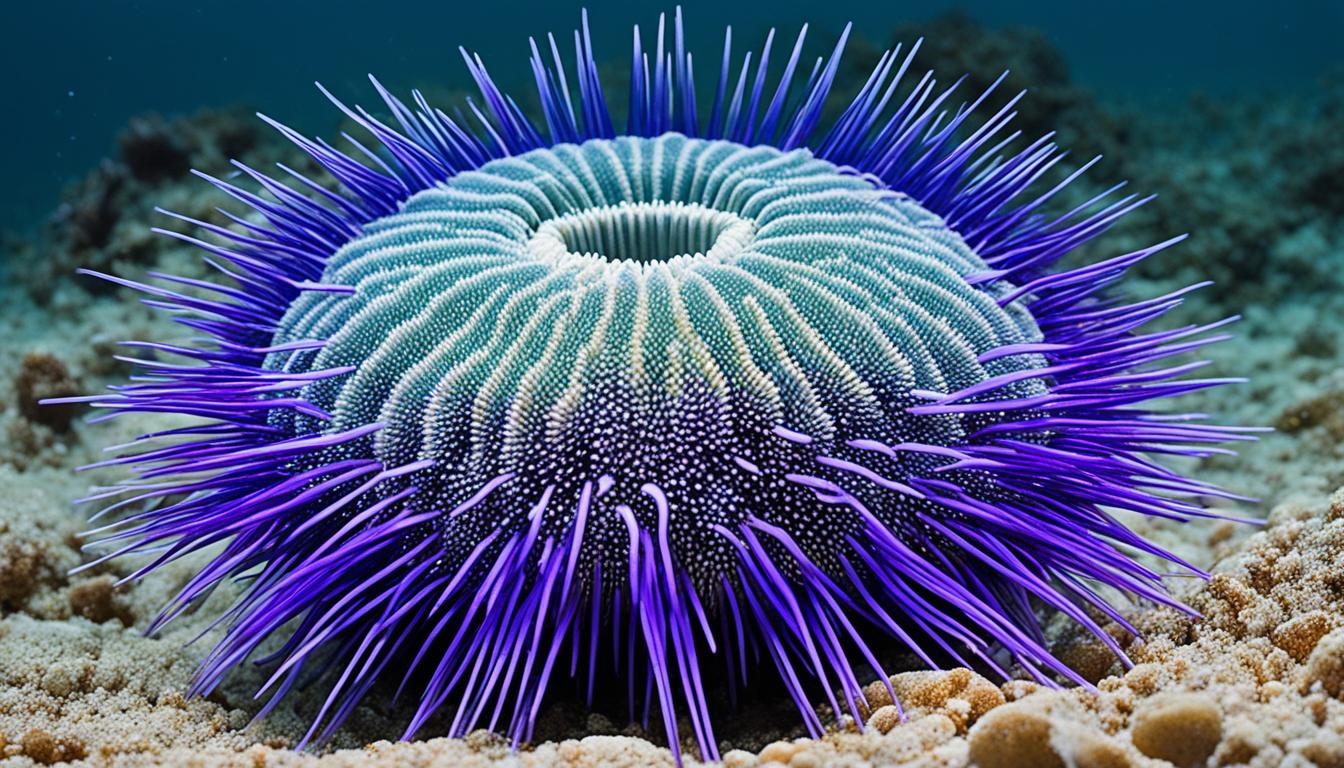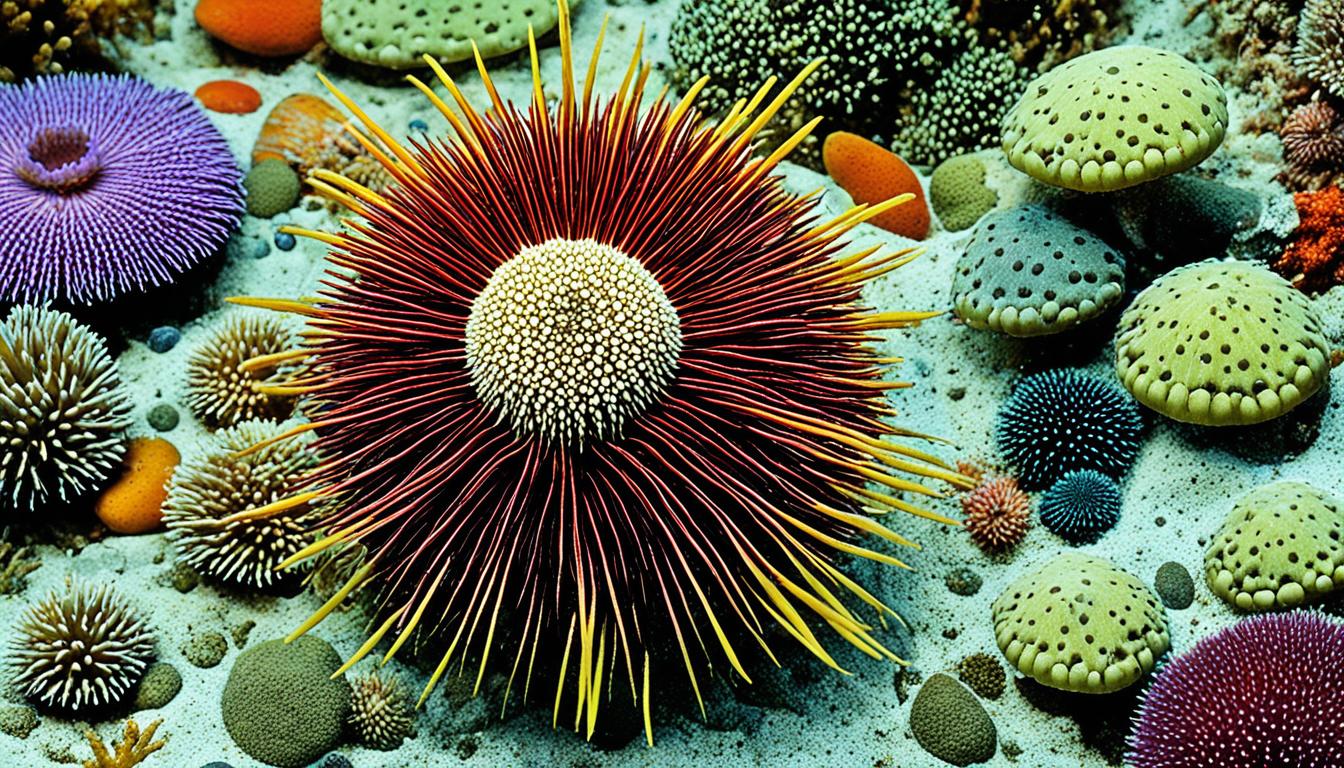Have you ever thought about emus living in the vast wilds of the USA? The majestic emu, known for its huge size and fast strides, raises some interesting questions. This discussion might change what you know about these amazing birds.
Emus are big, flightless birds that come from Australia. They are famous for their size and how quick they move. In fact, they can run as fast as 48 km/h (30 mph)! Emus are very important in Australian culture and history, often seen on the country’s coat of arms. But, sometimes, their numbers drop, leading to concerns about their survival.
So, here’s the big question: can you find emus naturally living in the USA? Or are these special birds only found in their home turf of Australia?
Introduction to Emus
The emu is the second tallest bird, after the ostrich. It is known scientifically as Dromaius novaehollandiae. Emus’ most notable features are their brown, soft feathers, long necks, and legs. They reach up to 1.9 meters (6 feet 3 inches). These flightless birds are from Australia. However, they now live in habitats in the USA, too.
What are Emus?
Emus are fascinating because of their size and looks. They have brown feathers that keep them warm in different weather. Their long legs let them run fast, up to 48 km/h (30 mph). This speed helps them get away from animals that might want to eat them. In the wild, emus can live for 10 to 20 years.
Where are They Typically Found?
Emus mainly live in Australia’s mainland. Their home includes coastal areas and dry places further inland. They can live in many places, like woodlands and grasslands. Even though they’re from Australia, you can also find them in the USA. There, they live in special places like zoos and farms.
Emus in Their Natural Habitat
Emus are iconic birds known for their huge presence in Australia’s many ecosystems. They have a long history, with fossils showing their origins in Australia during the Middle Miocene. Today, you can find emus across most of the main Australian continent and a few small spots.
Australian Origins
Emus come from Australia, a place they’ve called home for millions of years. They live in places ranging from the dry outback to the coasts. Thanks to their ability to adapt, they thrive not only on the mainland but also on nearby islands. The past, as shown by fossil evidence, highlights their resilience over time.
Current Distribution
Today, you can see emus mainly in mainland Australia. People have also introduced them to places like Maria Island and Kangaroo Island. The number of emus varies due to the changing environment. Estimates from 2009 put their numbers between 630,000 to 725,000. Even with these changes, emus stand out in their home landscapes.
There are talks about emus in North America and the emus natural habitat USA. Yet, it’s important to note that Australia holds deep connections to these birds. It is where they are most at home and plentiful.
| Region | Population Estimate (2009) |
|---|---|
| Mainland Australia | 600,000 – 700,000 |
| Maria Island | Varied |
| Kangaroo Island | Varied |
Are there any native emus in the USA?
Answering the question are there any native emus in the USA?, we need to know, emus come from Australia. They have always been there naturally. People tried to bring them to North America from Australia. Yet, there is a big debate about if they really lived here without humans bringing them over.
If you search for emus in the United States now, you’ll mainly see them in zoos, on farms, and in conservation work. They are kept for both saving the species and making products. This includes big efforts to make sure their numbers stay healthy.
Let’s look closer at emus in the United States:
| Location | Purpose | Population |
|---|---|---|
| Zoos | Conservation and Education | Moderate |
| Farms | Commercial Farming | High |
| Private Reserves | Breeding Programs | Varied |
The debate about native emus in the USA is still interesting to bird scientists and fans. No proof has been found that they lived here without help. But, emus in farms and zoos keep the mystery alive for many people.
Historical Accounts of Emus in America
The story of emus in the U.S. is quite interesting. The bird comes from Australia. Tries to make them at home in America have shown us how animals find ways to live in new places.
Early Reports
In 1696, European explorers saw emus for the first time in Australia. They shared about these unique birds back in Europe. But, there’s no evidence that emus lived in North America at that time.
Introduction Attempts
Many tried to bring emus out of Australia. This is well-documented in Maria Island and Kangaroo Island. But, there’s no proof that North America had its own emu species then. Today, emus in the U.S. come from efforts related to farming, research, and protecting the species.
Scientific Classification of Emus
Emus are part of the genus Dromaius. They are known by the one species, Dromaius novaehollandiae. This bird is Australia’s biggest native bird. It is famous for its speed and the important job it does in the environment.
Taxonomy
The emu is in the family Casuariidae according to its Taxonomy. It is from the ratite family, just like ostriches, rheas, and kiwis. However, the emu stands out because it only lives in Australia. It is not found anywhere else in the world.
Species and Subspecies
The main emu species is Dromaius novaehollandiae. It has several subspecies. Each subspecies lives in a different part of Australia. These subspecies look a bit different in size and color.
Some emu Species and Subspecies have become extinct. This includes the dwarf emus like D. n. baudinianus and D. n. minor. They lived on certain islands but disappeared after Europeans came. Their story reminds us how easily some species can vanish because of people and changes in their environment.
The Role of Emus in Australian Culture
Emus are key in Australian culture, symbolizing the nation’s unique wildlife and history. They stand for everything from survival to flexibility, defining Australia’s identity.
The emu’s role is highlighted on the Australian coat of arms with the kangaroo. This shows how important emus are as a cultural icon of Australia.
Indigenous Australian stories also feature emus, sharing lessons on strength and cleverness. This shows the bird’s spiritual significance to the Indigenous peoples.
Emus have played important roles throughout Australia’s history and in modern times. Their continued presence marks them as a cultural icon of Australia.
| Aspect of Culture | Representation |
|---|---|
| National Emblem | Australian Coat of Arms |
| Indigenous Mythology | Features in storytelling and lore |
| Symbolic Values | Strength, resilience, adaptability |
Emus are a window into Australian heritage and values, showing how deeply humans and nature interact. This bond is at the core of Australian culture.
Emus vs. Other Ratites
Emus are quite similar to other Ratite birds like ostriches, rheas, and kiwis. They’re all big, can’t fly, and have their own unique traits. These traits come from living in different places and behaving in their own ways.
Ostriches
Ostriches, found in Africa, are the biggest and tallest in the Ratite family. They can get up to 9 feet in height and reach 320 pounds. Unlike emus, ostriches live in Africa’s savannas and deserts. They have a special two-toed foot that helps them run up to 60 mph, which is faster than emus.
Rheas and Kiwis
Rheas, from South America, are a bit smaller than emus and ostriches, standing at about 5 feet tall. They live in open grasslands and have three-toed feet for moving easily. This makes them suited for their habitat more than emus.
Kiwis, found in New Zealand, are the smallest Ratites, being only 18 inches tall. They live in forests and have a great sense of smell for finding food at night. Emus, on the other hand, are great at seeing and running during the day in Australia’s diverse lands.
| Species | Native Habitat | Height | Distinct Features |
|---|---|---|---|
| Emu | Australia | Up to 6 feet | Brown plumage, long legs, sprint speed up to 30 mph |
| Ostrich | Africa | Up to 9 feet | Two-toed feet, running speed up to 60 mph |
| Rhea | South America | Up to 5 feet | Three-toed feet, adapted to grasslands |
| Kiwi | New Zealand | Up to 18 inches | Nocturnal, keen sense of smell |
Emus in American Zoos and Farms
In the United States, emus are common sights in zoos and farms. These large, flightless birds came from Australia. They are looked after carefully in these settings. This helps them stay healthy and ensures they can keep thriving.
Conservation Efforts
Emus play a key role in saving their species in American zoos. These efforts teach people about emus and keep their gene pool diverse. Zoos work on projects to have more emus born, which helps both in captivity and in the wild.
Commercial Emu Farming
There’s a special kind of farming for emus in the USA. It’s both a business and a way to protect the emus. This method provides meat, leather, and oil from the emus. It’s becoming more popular because these products are in big demand.
| Product | Benefits |
|---|---|
| Meat | Low in fat, high in protein, alternative to traditional meats |
| Leather | Durable, used in various fashion goods |
| Emu Oil | Medicinal properties, used in skincare and pharmaceuticals |
Challenges Emus Face Outside Their Native Habitat
Emus find it hard to adapt to new places. They are big birds from Australia. They are used to Australia’s varied climates and landscapes. So, when they are moved to new areas, they suffer.
Climate and Environment
The weather is a big problem for emus in new places. Australia has all kinds of weather, from dry deserts to green forests. Emus do well in this, but they have trouble in colder or more humid places. The big change in weather affects their health and how long they live.
Food Sources
Getting their usual food is another big issue. In Australia, emus eat plants, bugs, and small animals they find in the wild. But, finding similar food in new places is hard. This can make them not eat right, which is bad for their health.
It’s important to watch over emus closely when they are in new places. This helps them adapt better and stay healthy.
American Emu Population Trends
The American emu population has grown a lot. This is mostly because of emu farming. Many farms in the USA support a large and healthy group of these large, flightless birds.
To see how the emu population in the USA changes, we need to look at farming and product needs. People like emus for their meat, leather, and special emu oil. This oil is valuable for its healing effects.
Below is a table showing the American emu population changes by year and state. It shows the ups and downs and how some states are seeing more emus:
| Year | State | Population |
|---|---|---|
| 2010 | Texas | 12,000 |
| 2015 | California | 8,000 |
| 2020 | Florida | 5,000 |
| 2023 | North Carolina | 3,500 |
This data shows emus are doing well in diverse places in the USA. The farming of emus makes economic sense too. As more people want emu products, the population of these birds will probably grow even more.
Commercial Uses of Emus in the USA
In the USA, emus are mainly farmed for their valuable products. This includes meat, leather, and oil. These items are highly valued across different industries for their special properties.
Meat and Leather
Emu meat is a healthy alternative to red meats. It’s low in fat and cholesterol. Emu meat tastes similar to beef but is healthier. This makes it great for many dishes. Emu leather is also highly prized. It’s strong and soft, used in making top-quality fashion items like boots and jackets.
Medicinal Uses of Emu Oil
Emu oil is known for its health benefits. It’s packed with Omega fatty acids, which help with inflammation and keep skin moisturized. This oil is great for cosmetic products and helps relieve conditions like arthritis. It’s used in lotions and creams to improve skin health and reduce swelling.
So, what makes each product stand out? Let’s compare their values:
| Product | Main Benefits | Industries | Comparison |
|---|---|---|---|
| Emu Meat | Low-fat, high-protein, rich in iron | Food and Beverage | Similar in taste and texture to beef but healthier |
| Emu Leather | Durable, pliable, high-quality | Fashion and Apparel | Softer and more durable compared to traditional leather |
| Emu Oil | Anti-inflammatory, rich in essential fatty acids | Cosmetic and Pharmaceutical | More effective for skin penetration and inflammation reduction compared to common oils |
Why Emus Are Not Native to the United States
Emus are flightless birds from Australia. They are known scientifically as Dromaius novaehollandiae. These birds are well-suited for Australia’s different terrains, from the coasts to the deserts. Their strong running skills and unique body features help them live in the wild.

Why are emus not native to the United States? It’s because of their history and where they come from. Emus have been in Australia for thousands of years, living with the land. Their info in the USA is because people brought them for various reasons. This includes zoos, saving the species, or for business.
Emus in the United States have their important jobs. They can be the main attraction in zoos or a source of goods in farms. But, emus not native to the United States are not found naturally there. They are managed carefully to keep them and the environment safe.
Looking at why emus are not native to the United States shows a mix of things. This involves the land, how things have changed over time, and what people have done. Although they can do well with people, Australia is where they truly belong. There, they are a key part of the environment.
Impacts of Emu Farming in North America
Emu farming in North America has big effects beyond farming. It boosts the economy by selling emu products like meat, leather, and oil. Emu meat is a healthy choice, being leaner and less fatty than beef.
Emu leather is tough and has a unique feel, making it popular in fashion. But, there are deeper impacts than just making money.
Emus are not native to North America. Keeping them in farms can help protect the local environment. But, there’s a risk of them getting loose. This could harm the local plants and animals. So, farming practices must be careful to prevent this.
Aside from the money and environment, emu farming changes how we farm. Farmers may start using more eco-friendly methods because of emu farms. Also, the products from emus can lead to new ideas in farming and how we sell farm goods. These changes offer new choices for consumers.
FAQ
Are there any native emus in the USA?
No, the USA doesn’t have its own emu species. Emus come from Australia. Humans brought emus to other places.
What are Emus?
Emus are big, flightless birds from Australia. They come after ostriches in height. Emus have long legs and necks. They stand out with their soft, brown feathers and can run fast.
Where are emus typically found?
Emus are spread all over mainland Australia. They live in different areas, from savannas to forests and grasslands.
What are the origins of emus?
Emus first appeared in Australia. Fossil records show they’ve been there for millions of years, since the Middle Miocene period.
What is the current distribution of emus?
Today, emus are found in many parts of Australia. They’ve also been placed in places like Maria Island and Kangaroo Island.
Are there any native emus in the USA?
The USA doesn’t naturally have emus. The emus there are from elsewhere, mainly from being kept in zoos and farms.
What are the historical accounts of emus in America?
Some say European explorers saw and brought emus to America. But, there’s no proof that emus are native to the Americas.
What attempts have been made to introduce emus to America?
People have tried bringing emus to America for farming and saving the species. Yet, these emus aren’t originally from the region.
What is the scientific classification of emus?
Emus are in the Dromaius genus. Their full scientific name is Dromaius novaehollandiae. They are flightless birds in the Ratite group.
What are the species and subspecies of emus?
Dromaius novaehollandiae is the main emu species. There were subspecies and some aren’t around anymore, like D. n. baudinianus and D. n. minor.
What role do emus play in Australian culture?
Emus are very important in Australia. They’re on the coat of arms. Also, they’re part of Aboriginal stories and culture.
How do emus compare to other ratites like ostriches, rheas, and kiwis?
Emus are similar to other ratites like ostriches. But, they live in different areas and look different. E.g., ostriches are taller, and kiwis act differently.
What efforts are being made to conserve emus in American zoos?
American zoos have emus. This is to help keep the species safe. It’s also to teach people about their history.
What is commercial emu farming?
It’s about breeding emus for meat, leather, and oil in the USA. This supports economic and agricultural goals.
What challenges do emus face outside their native habitat?
In non-native places, emus can find it hard to adapt and get food. This can make it tough for them to live and reproduce.
What are the trends in the American emu population?
The number of emus in America changes with the success of farming. There isn’t a large group of wild emus in the country.
What are the commercial uses of emus in the USA?
In the USA, emus are used for meat, leather, and oil. Emu meat is healthy. Emu oil has medical value.
Why are emus not native to the United States?
Emus are from Australia, not the USA. They were brought over by people for different reasons.
What are the impacts of emu farming in North America?
Emu farming affects the economy. Products are sold. There’s also thought about the environment. But farms usually keep emus in controlled areas to reduce harm.










